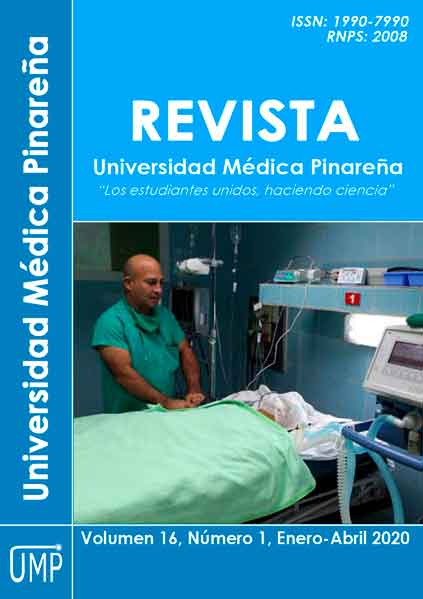Behavior of cranioencephalic trauma at “Abel Santamaria Cuadrado” General Teaching Hospital
Keywords:
Brain Injuries, Traumatic, Trauma, Nervous System, Surgical Procedures, Operative.Abstract
Introduction: cranioencephalic trauma constitutes a global health problem, and it is characterized by cerebral alterations after a traumatic injury to the skull.
Objective: to characterize patients with cranioencephalic trauma attended at Abel Santamaria Cuadrado General Teaching Hospital in Pinar del Río, from January to December 2016.
Methods: descriptive, cross-sectional and observational study that was carried out at Hospital at Abel Santamaria Cuadrado General Teaching Hospital, Pinar del Río, in 2016. A sample of 125 patients with clinical-imaging diagnosis of cranioencephalic trauma from a target group of 178 patients was probabilistically chosen at random. Clinical histories were analyzed to collect the information that gave rise to the variables studied. Medical ethics principles were met.
Results: male patients predominated (79,2 %), with a mean age of 57,1 ± 19,1 years. Alterations in the level of consciousness were the main clinical manifestations upon admission (46,4 %), with brain contusion (31,2 %) and skull fracture (31,2 %) being the main imaging findings; 39,2 % of the patients underwent surgery, where the 27,2 % of them presented complications, cerebral edema (41,18 %) was the main problem. On discharge, patients with no functional disability predominated (70,48 %).
Conclusions: male patients, in their fifth decade of life, are prone to suffer a cranioencephalic trauma, presenting alterations in the level of consciousness upon admission, generally with the presence of encephalic contusion and cranial fracture when imaging tests were performed. Surgical treatment was required in most patients, where edema appears as a common complication.
Downloads
References
2. Nguyen R, Fiest KM, McChesney J, Kwon CS, Jette N, Frolkis AD, et al. The International Incidence of Traumatic Brain Injury: A Systematic Review and Meta-Analysis Can J Neurol Sci [Internet]. 2016 [citado 26 Dic 2019]; 43: 774-785. Disponible en: https://doi.org/10.1017/cjn.2016.290
3. Bonow RH, Barber J, Temkin NR, Videtta W, Rondina C, Petroni G, Lujan S, et al.
The Outcome of Severe Traumatic Brain Injury in Latin America. World Neurosurgery [Inernet]. 2018 [citado 23 Nov 2019]; 111:e82-e90. Disponible en: https://doi.org/10.1016/j.wneu.2017.11.171
4. Donéstevez de Mendaro ARA, Cañizares Luna O, Alba Pérez LC, Alegret Rodríguez M. Caracterización neuropsicológica de pacientes con trauma craneoencefálico frontal leve y moderado. Acta Med Cent [Internet]. 2017 [citado 26 Dic 2019]; 11 (2):4-9. Disponible en: https://www.medigraphic.com/pdfs/medicadelcentro/mec-2017/mec172b.pdf
5. Sierra Benítez EM, León Pérez MQ, Rodríguez Ramos E, Pérez Ortiz L. Caracterización clínico-quirúrgico, neuroimagenológico y por neuromonitorización del trauma craneoencefálico en la provincia matanzas. 2016-2018. Rev Méd Electrón [Internet]. 2019 [citado 26 Dic 2019]; 41 (2): 368-381. Disponible en: https://www.medigraphic.com/pdfs/revmedele/me-2019/me192f.pdf
6. Herrera Martínez MP, Ariza Hernández AG, Rodríguez Cantillo JJ, Pacheco Hernández A. Epidemiología del trauma craneoencefálico. Rev Cub Med Int Emerg [Internet]. 2018 [citado 26 Dic 2019]; 17 (S2): 3-6. Disponible en: https://www.medigraphic.com/pdfs/revcubmedinteme/cie-2018/cies182b.pdf
7. Donéstevez de Mendaro ARA, Cañizares Luna O, Alba Pérez LC, Alegret Rodríguez M. Caracterización epidemiológica y neurológica del traumatismo craneoencefálico frontal durante cinco años en Villa Clara. Medicentro [Internet]. 2017 [citado 26 Dic 2019]; 21(1): 30-38. Disponible en: https://www.medigraphic.com/pdfs/medicentro/cmc-2017/cmc171e.pdf
8. Giner J, Mesa Galán L, Yus Teruel S, Guallar Espallargas MC, Pérez López C, Isla Guerrero A, et al. El traumatismo craneoencefálico severo en el nuevo milenio. Nueva población y nuevo manejo. Neurología [Internet]. 2019 [citado 26 Dic 2019];[article in press] Disponible en: https://doi.org/10.1016/j.nrl.2019.03.012
9. Leon-Carrion J, Leon-Dominguez U, Pollonini L, Wu MH, Frye RE, Dominguez-Morales MR, et al. Synchronization between the anterior and posterior cortex determines consciousness level in patients with traumatic brain injury (TBI). Brain Res [Internet]. 2012 [citado 26 Dic 2019]; 1476:22-30. Disponible en: https://www.ncbi.nlm.nih.gov/pubmed/22534483
10. Thompson HJ, Dikmen S, Temkin N. Prevalence of comorbidity and its association with traumatic brain injury and outcomes in older adults. Res Gerontol Nurs [Internet]. 2015 [citado 15 Nov 2019]; 5(1):17-24. Disponible en: https://www.ncbi.nlm.nih.gov/pubmed/22165997
11. Bermúdez-Ruíz JA, Merlán-Martínez M, Vitón-Castillo AA, Brunet-Liste JV, Lara-Merlan LM. Caracterización de pacientes con traumatismo craneoencefálico severo atendidos en el Hospital Arnaldo Milián Castro. Univ Méd Pinareña [Internet]. 2020 [citado 2020 Ene 20]; 16(1):e376. Disponible en: http://www.revgaleno.sld.cu/index.php/ump/article/view/376
12. Rosabal Rosales DD, González Aguilera JC. Alteraciones clínicas y humorales como factores pronóstico en pacientes con traumatismo craneoencefálico grave. 16 de Abril [Internet]. 2016 [citado 23 Nov 2019]; 55(261): 1-10. Disponible en: http://www.rev16deabril.sld.cu/index.php/16_04/article/view/325
13. Petgrave-Pérez A, Padilla JI, Díaz J, Chacón R, Chaves C, Torres H, et al. Perfil epidemiológico del traumatismo craneoencefálico en el Servicio de Neurocirugía del Hospital Dr. Rafael A. Calderón Guardia durante el período 2007 a 2012. Neurocirugia [Internet]. 2015[citado 23 Nov 2019];27(3):112-120. Disponible en: http://dx.doi.org/10.1016/j.neucir.2015.10.003
14. Valdez Zambrano VF, Marín Cherrez AW, Muñoz Avilés VA, Minda Reyes JA. Atención prehospitalaria en trauma craneoencefálico. RECIMUNDO [Internet]. 2019 [citado 14 Ene 2020]; 3(3):183-00. Disponible en: http://www.recimundo.com/index.php/es/article/view/517
15. Yepes Bustamante MM, Quintana Pájaro L, Gil Barrera S, Rodríguez Cantillo J, Corrales Santander H, Moscote Salazar LR. Imagenología del neurotrauma en la etapa aguda. Rev Cub Med Intensiva [Internet]. 2018 [citado 23 Dic 2019]; 17(S2): 92-99. Disponible en: https://www.medigraphic.com/pdfs/revcubmedinteme/cie-2018/cies182o.pdf
16. Flynn-O’Brien KT, Fawcett VJ, Nixon ZA, Rivara FP, Davidson GH, Chesnut RM, et al. Temporal trends in surgical intervention for severe traumatic brain injury caused by extra-axial hemorrhage, 1995 to 2012. Neurosurgery [Internet]. 2015 [citado 23 Dic 2019];76: 451-60. Disponible en: https://www.ncbi.nlm.nih.gov/pubmed/25710105
17. Ginera J, Galán LM, Teruel SY, Guallar Espallargas MY, Pérez López C, Isla Guerrero A, et al. El traumatismo craneoencefálico severo en el nuevo milenio. Nueva población y nuevo manejo. Neurología [Internet]. 2019 [citado 23 Dic 2019]; [in press]. Disponible en: https://doi.org/10.1016/j.nrl.2019.03.012







